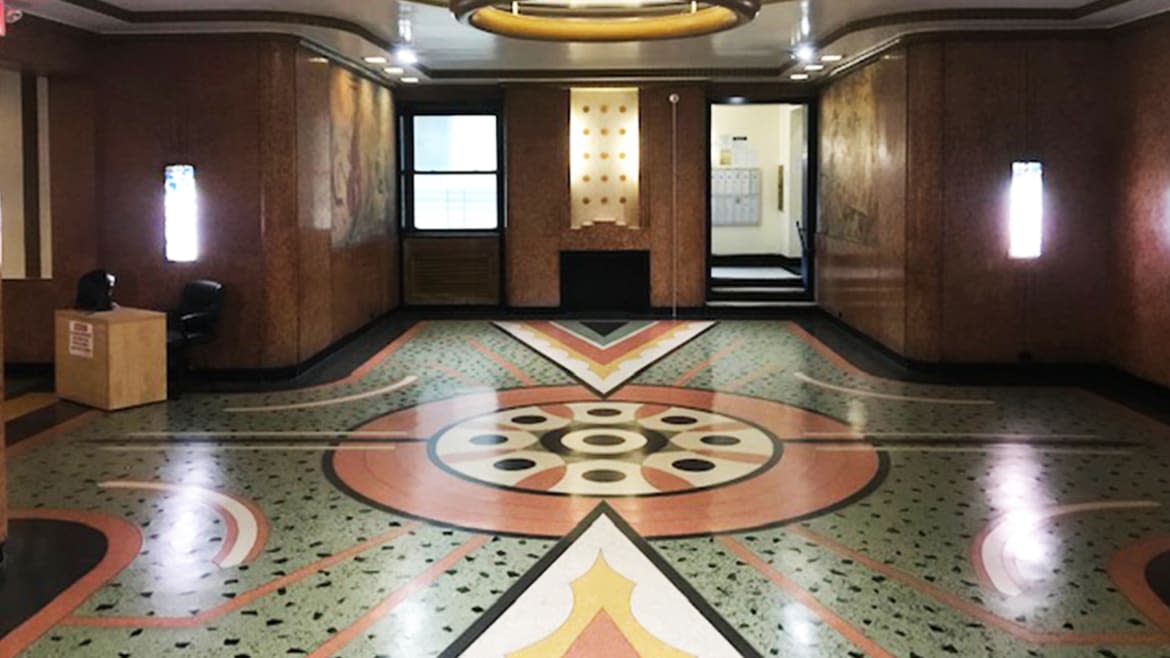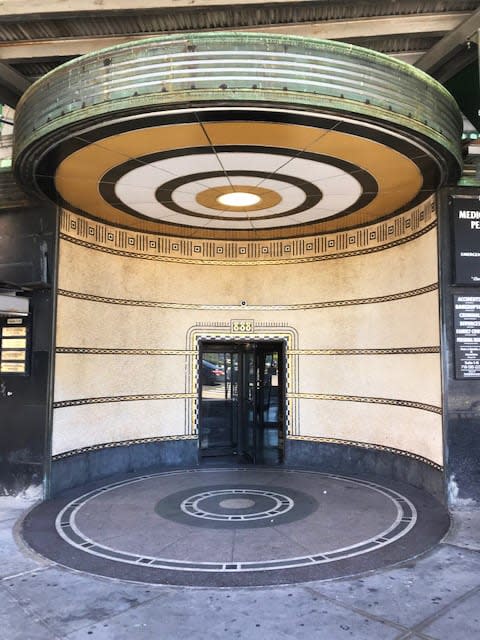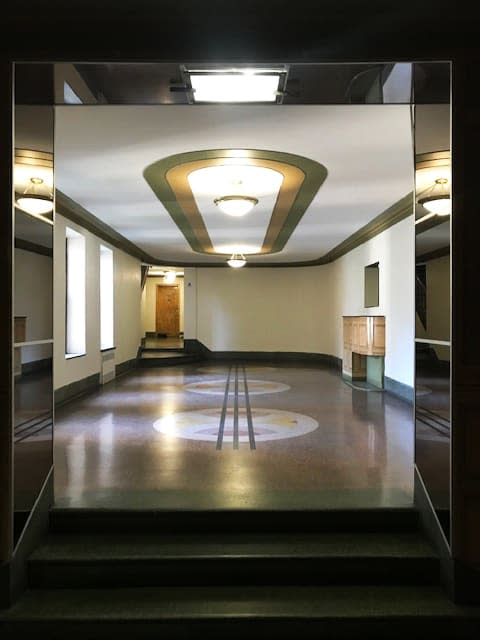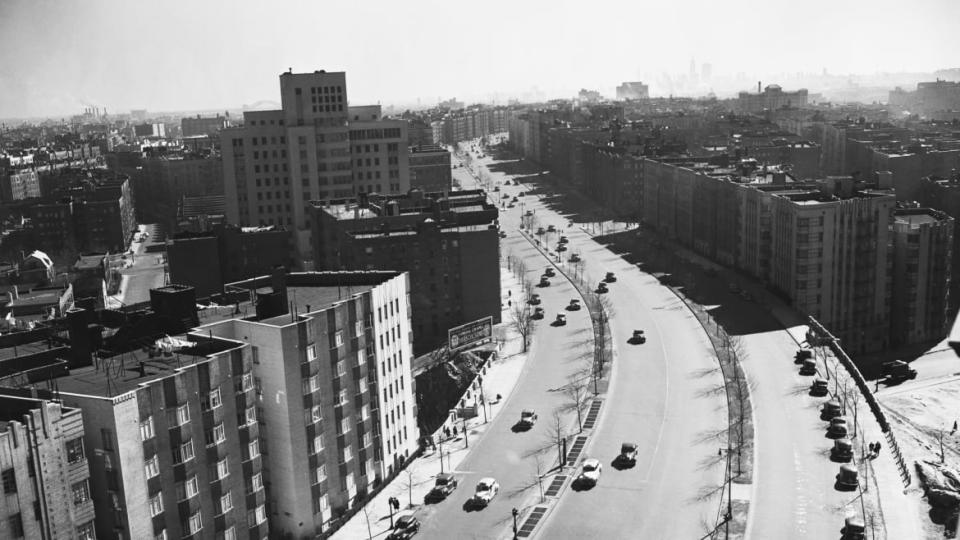This Should Be Your Next Big Stroll in NYC

You might be marooned by COVID-19 right now in some dreary northeastern apartment sustained only by reveries about Miami, Los Angeles or Mumbai, or some other place you won’t be visiting anytime soon—and overlooking one of the best Art Deco neighborhoods in the country—right in the Bronx.
It’s time to get out of the house and catch up on attractions in your own backyard. The area surrounding the Grand Concourse in that borough contains over 300 Art Deco and Art Moderne buildings, one of the densest concentrations in the US. These generally aren’t civic icons on the level of the Chrysler or Empire State buildings (few things are!) but there are a ton in one spot, and not one charges an entry fee. If you’ve any interest in the style and are anywhere nearby, you have no excuse for failing to head over.
The architecture of the Grand Concourse is not pastel-splashy at the street level like its semitropical cousins. The buildings that first come to mind as exemplars of balmier Art Deco are often hotels or theaters or commercial buildings. Their dramatic marquees, spires, crowns, colors, and lighting schemes were advertisements in themselves, designed to draw in new customers every day. The Bronx buildings are overwhelmingly residential and didn’t need to lay on the charm quite so aggressively at the facade level but they often do, in a huge way, once you step inside. A number of their lobbies are as exuberant as the form can get; it’s the hard-working South Bronx outside, but South Beach inside.
The exteriors are extremely deft, impressive even if you’re speeding by, but you need to need to get out and walk around. Constance Rosenblum writes in an excellent history, The Boulevard of Dreams: Heady Times, Heartbreak, and Hope along the Grand Concourse in the Bronx:
The façades are remarkable in two respects. One involves the imaginative way the architects used such devices as setbacks, recessed entryways, and rounded corners to break up the typically flat exterior wall. The other has to do with how architects manipulated mosaics, glass, metal, brick, concrete, and expensive wood such as teak and mahogany to underscore these effects and at the same time to appeal powerfully to the senses.
You’ll find imaginative uses of brick around every curve of the concourse, with multiple shades, patterns, bandings, ridges, rises, crenellations, and more putting to shame the mindless ways in which we usually just stack the poor things. Pay attention because there’s always something going on. These bricks are set off by fancier materials, with marble, other masonry, chrome, and gold adding luxe touches. There are some portholes, a surrealist fish mosaic, gaudy elevator doors, interior murals, statues, wild terrazzo patterns, and much more. Hidden in plain especially are lobby-scaled visions of Hollywood RKO sets, missing only Fred Astaire and Ginger Rogers, William Powell or Myrna Loy, and well, yourself.

888 Grand Concourse exterior
The Grand Concourse lives up to its hyperbolic title in large part thanks to those buildings lining its sides, although it would be an impressive road in any case. It was designed as a Haussman-light boulevard by a French immigrant, Louis Aloys Risse, who became Chief Engineer of street improvements in New York. He imagined the road as a capacious carriageway to convey Manhattan residents to the countryside but this vision was soon overtaken by urban growth, as the automobile and subway ensured that six- to seven-story apartment buildings rapidly filled the street
We are extremely lucky that the Grand Concourse opened at a prime stylistic moment; shudder to imagine how boring this might have been in 1945, 1965, or 2015. Not-so-benign neglect had its fringe benefits in later decades in ensuring these buildings didn’t fall to the wrecking ball in subsequent waves of rebuilding. Such waves never happened.
The easiest start for taking this all in is probably the 149th Street-Grand Concourse stop on the 2/4/5 trains, just two stops from Manhattan and a stone’s throw from Yankee Stadium. The 1937 Bronx Annex post office building stands here. It’s a product of the same era as its Deco peers, if quite different, semi-neoclassical but mainly ornament-less in an unmistakably 1930s sort of way.
There are fine statues flanking the entrance. You unfortunately can’t really see the main attraction, peak New Deal-ish interior murals by Ben and Bernarda Bryson Shahn, due to the building’s lengthy conversion to retail and office uses. In the interim, try right here.
The Post Office provides an excellent image to keep in mind for encountering the Art Deco apartments along the Grand Concourse. It is aggressively four-corner-rectilinear-cubical; the Deco buildings along the boulevard are anything but, with setbacks and zigzags providing numerous corners. Everyone loves a trademark Deco corner casement window but a boring four-cornered building would only give you a miserly four. The numerous setbacks of these Art Deco buildings provide for up to a dozen.
730-750 Grand Concourse features three buildings designed by the same architect, Jacob Felson, featuring exactly such setbacks, ornamental brick, and stylish curving fire escape railings. The lobby at 750 is worth a look, the first of several fine terrazzo patterned floors, with brass ornament and palm accents. Now, to be clear, to get into these lobbies you’ll need to ask doormen or residents. Being shy or retiring will get you literally nowhere! Every one I asked happily assented, some talking enthusiastically about their buildings.
There’s another massive cube that follows soon after, the Bronx County building, another doughty-if-impressive Rooseveltian four-freedoms four-cornered landmark. It features a large frieze depicting agriculture, commerce, industry, and the arts by prolific sculptor Charles Keck. Statues are also impressive. Interior murals by James Monroe Hewlett (responsible for the Grand Central Station ceiling) display scenes of Bronx history. Your ability to go in might be chancy in the COVID era, until then, take a look here.
Across the street there’s a building that doesn’t just sit on a corner but makes it, one of few along the Grand Concourse by a prominent architect, Hungarian Emery Roth, also responsible for the El Dorado and San Remo on Central Park West. There is an element of a theater marquee about its entrance, the center of three rounded corners scooped out to create a void in this wave of curves, a canopy framed by white black and gold, accented by gold bands, stainless steel, and a ceiling mosaic. Peer into the lobby at least as well, where there’s more fine patterns surrounding a sculpture.
Most of the architects who designed notable buildings along the Grand Concourse were Jewish (if none quite as famous as Roth), unsurprising for a neighborhood that was mainly Jewish, with substantial Italian and Irish elements (non-white minorities would have had no luck in the face of racist rental policies). The Grand Concourse was a symbol of a prosperous and new future, and for many the first stop on the economic ladder out of overcrowded Lower East Side tenements. These buildings were overwhelmingly the reverse of nouveau riches ostentation, typically pairing well-tailored but understated exteriors with swank interiors. They’re also a study in careful costs in many cases. Art Deco can be extremely expensive, but many of these buildings obviously weren’t. The style leans on the right selective ornament, and could often be relatively economical. The right selective indulgence makes everything look much better—terazzo is unquestionably expensive but lasts. Many of these lobby floors are in shockingly good shape.
Not every building on the street is a standout, but they set the (high) tone of the broader architectural conversation. Sociologist Marshall Berman grew up nearby, and noted that for his parents, “the Concourse buildings represented a pinnacle of modernity. We couldn’t afford to live in them—though we did live in a small, modest, but still proudly ‘modern’ building down the hill—but they could be admired for free, like the rows of glamorous ocean liners in port downtown.”
Other famous residents included Paddy Chayefsky, Stanley Kubrick, EL Doctorow, Regis Philbin, and Jules Feiffer.
Israel Krausman’s 910 is your next attraction, with a cast-stone portico and Moderne details all around. Here is a lobby to take in—a black, gold, and yellow terrazzo pattern with a wonderful mural inside, whose artist I could not discover, but which bears text from Joyce Kilmer’s “Roofs.”

Admire 1001 Grand Concourse, designed by Horace Ginsbern, who designed several excellent buildings here. A benefit of this whole journey is the ability to see several talented architects experiment in the course of a relatively modest walk. There’s no need to drive all over town or states to take in variations on themes and new stylistic experiments of several very talented architects. Many are on a single street.
1035 Grand Concourse, another Ginsbern, features one of the more flamboyant entrances on the concourse—a jaunty red and white porthole-like pattern, and a very impressive bright lobby in red green and white, along with a marvelous elevator door featuring a Wiener Werkstatte-esque pattern.
Then you’ll come upon possibly the greatest star of this production, Felson’s 1150, known as the “Fish Building.” This is one of few buildings engaged in real ostentation at the street level, with a wonderful tinted concrete mosaic on its exterior, an aquarium in two dimensions featuring Max Ernst-like surrealist fish. The lobby is sumptuous and essential as well. Red, green, and white terrazzo, ornate lighting, and rear-lit floral stained glass windows. Walls, which have suffered in some of these buildings, are superb here. Two original murals by Rene and C.P. Graves feature swans and maidens and an upright bass. I’m not sure what they mean but the feeling is strongly positive.
At 1166 a few blocks down, (another Felson) there is another lobby you can’t miss complete with another kinetic terrazzo pattern, chrome handrails, and small mosaics featuring antelopes and birds. The whole block is excellent.
Felson’s 1188 has been a little degraded with later tweaks (original steel casement windows are gone in a number of buildings but the grandeur is there even if faded in most cases) There’s still a very fine cream, black, and green circular lobby and an exceptionally nice doorman.
Look at 1227 and 1295 for more innovative exteriors. White and Willensky’s AIA Guide to New York City describes the exterior of Felson’s 1500 well, “The parapet limestone has been carved into folds, like velvet.” The lobby is another must-enter proposition. The initial chamber features a possibly gauche intrusion of patterned wallpaper, but the main attraction is in two curvilinear wings, where you’ll find a patterned terrazzo floor, some Pierre Chareau-like ceiling ornament, and a very Bauhaus stairway.

1500 Lobby
1505 features rarer but interesting triangular corners. Look to 1675 on your way. 1750 is the last vital lobby, with a complex green, black, yellow, and white terrazzo pattern and a streamline fireplace.
Another very real attraction for the walk is simply the road itself, possibly the most dramatic single artery in New York. Obviously there are other exceptionally impressive streets in New York, a list helmed by Olmsted’s Brooklyn parkways, but none wind for five miles along the top of a ridge, a siting that still ensures grand views from nearly every intersection. You’ll find grand views from nearly every corner (the Kingsbridge Armory is particularly elephantine).
Its design isn’t quite as fine as original, but at least it’s improved since its worst days, which can’t be said about almost everything surrounding the concourse. The 1960s saw a period of sustained economic decline with white flight and rising crime. Traffic lanes were widened as the concourse became an autobahn for speeding out of the Bronx instead of a showcase. Reconstruction beginning in the early 2000s has restored some of the concourse’s charms, if overall the road could still use an automobile diet.

"Most impressive thoroughfare in the Bronx, and one of the most beautiful in the city, is the Grand Concourse, which bisects the borough. It is lined for miles by apartment houses which command premium rentals. The concourse is a route northward to New England."
The neighborhoods along the route also recovered from their nadir, today hosting a very diverse variety of African-American, Central American, and West African communities. Dining nearby ranges from Ghanaian to Dominican to Vietnamese if exercise leaves you hungry.
There are other great buildings to the north, if slightly more spread out. 1855 and 1939 are both good. Expert zigzags can be found at Ginsbern’s 2121. 2255 is also a Ginsbern. The Loew’s Paradise theater is a fine sight and 2516, the former Emigrant Savings Bank, is being renovated but it’s tall enough to take in.
If you are greatly in need of exercise or bragging rights there is a wonderful curved Moderne structure on St. George’s Crescent near the northern end of the concourse (and Paul Rudolph’s brutalist monolith Tracey Towers, but that’s a story for a different age).
The spirit of the 1930s is alive and well on the Grand Concourse, certainly a little frowzy at points, but generally in surprisingly good shape. It’s also a vision of high style and fine design that’s not just the preserve of the wealthy, a very welcome vision in an age of wealth asserting everything to itself in New York. You too can partake in these very democratic attractions, so get out there.
Get our top stories in your inbox every day. Sign up now!
Daily Beast Membership: Beast Inside goes deeper on the stories that matter to you. Learn more.


